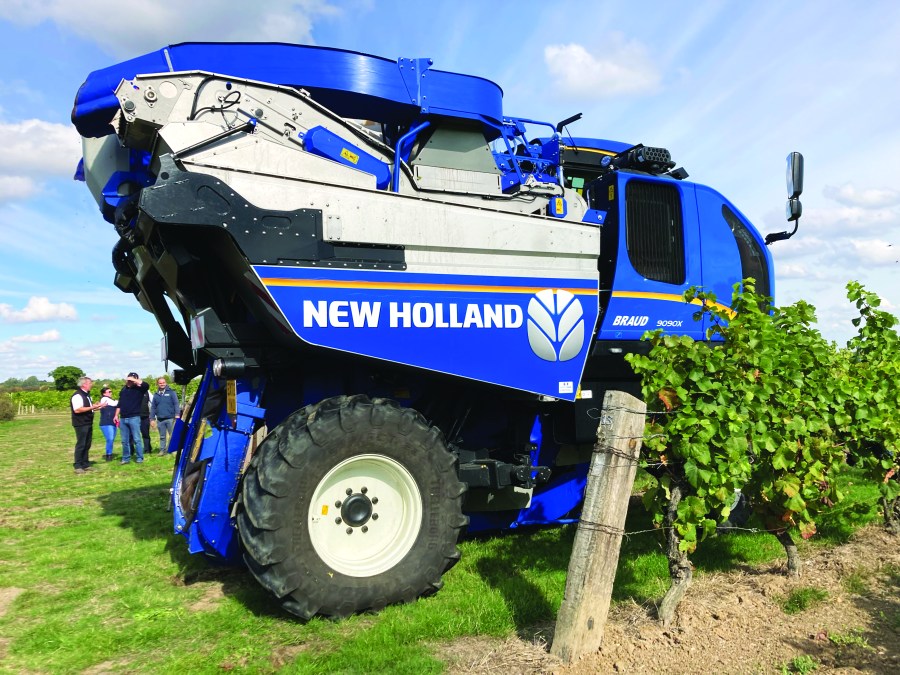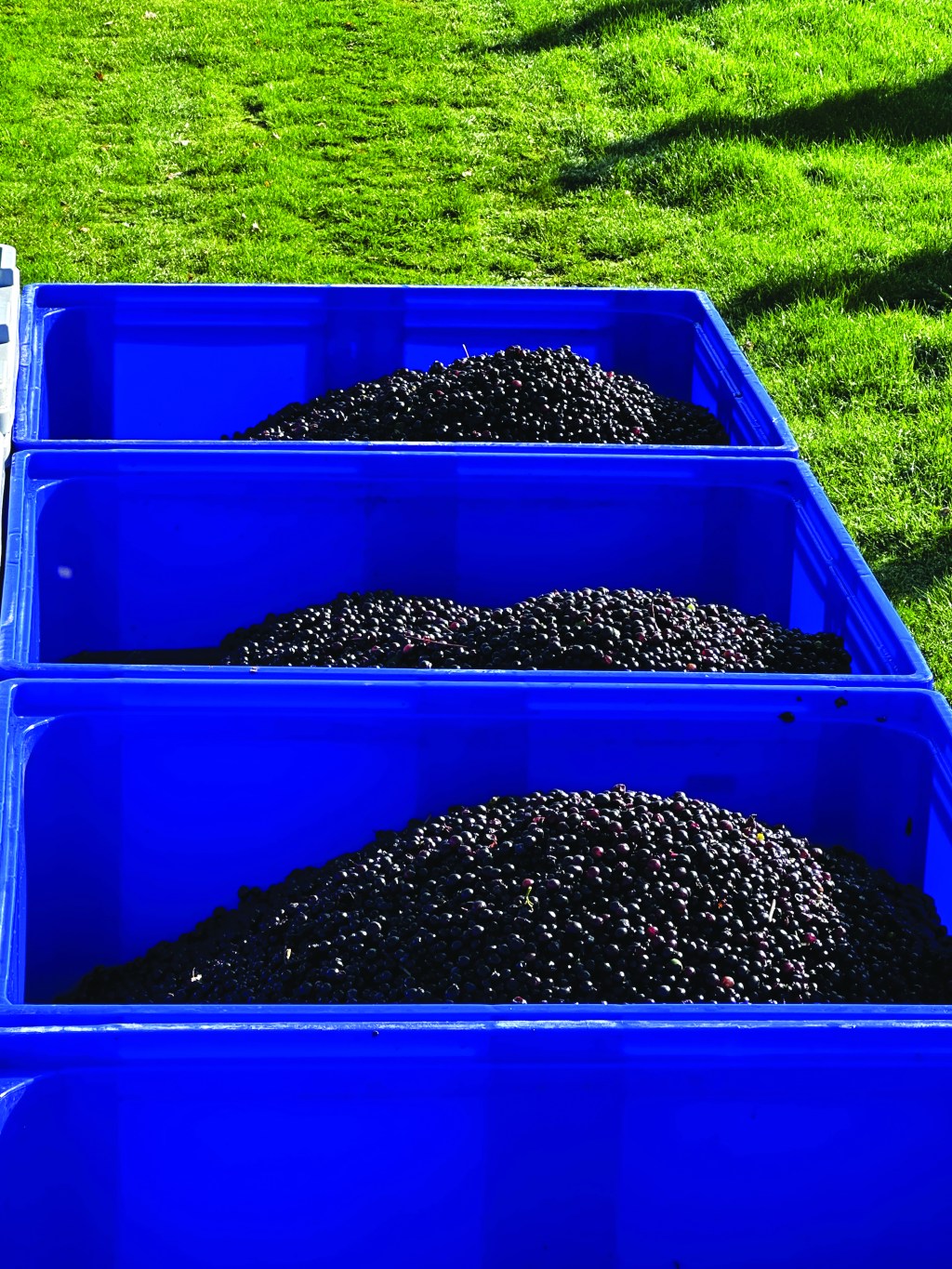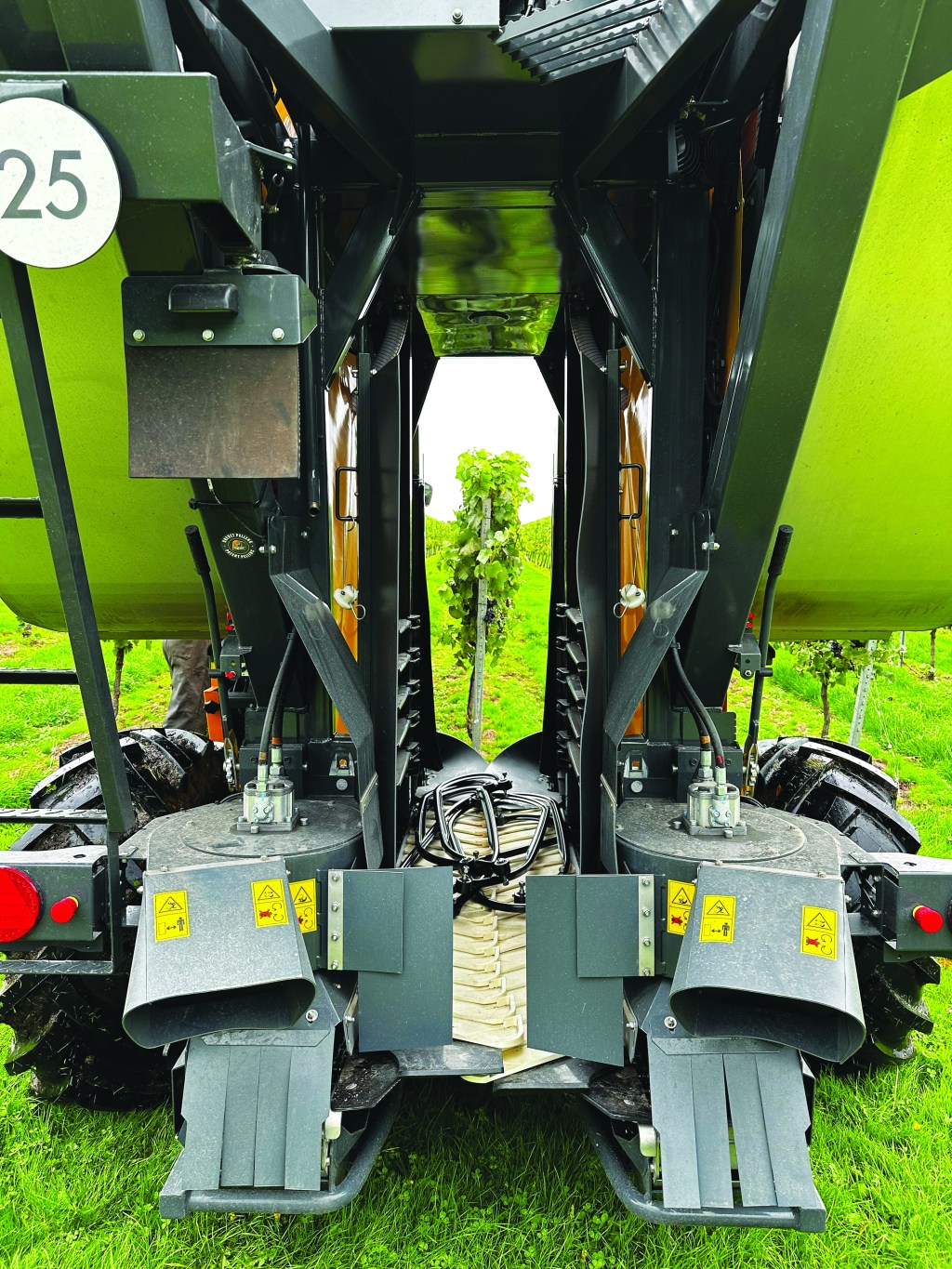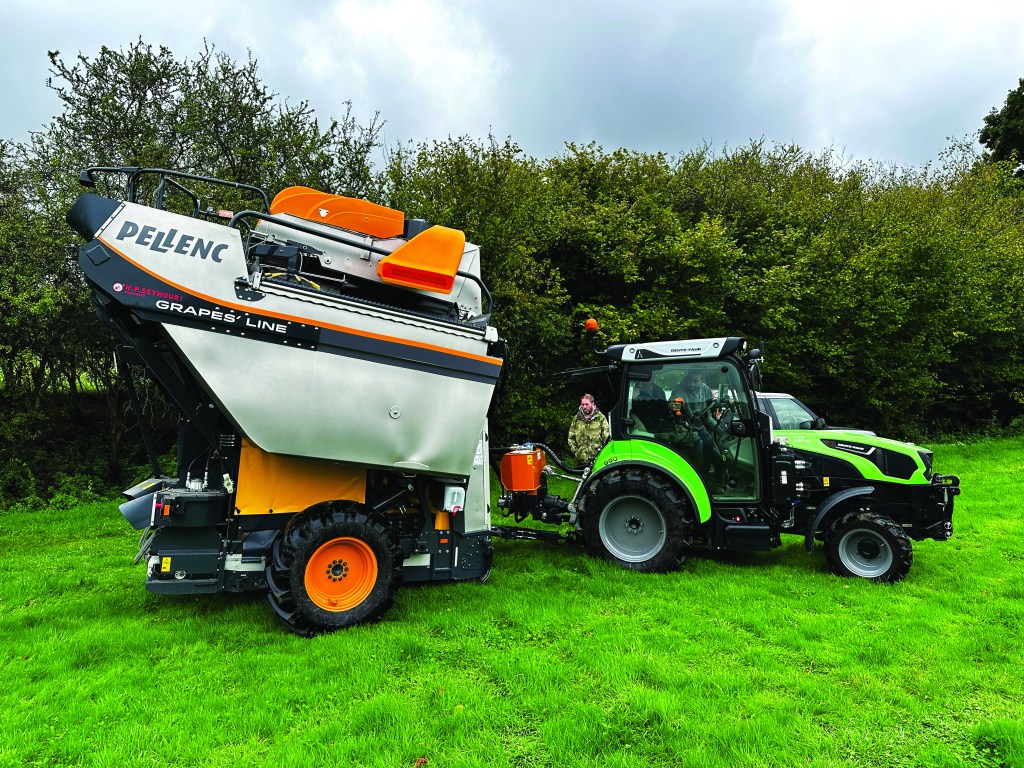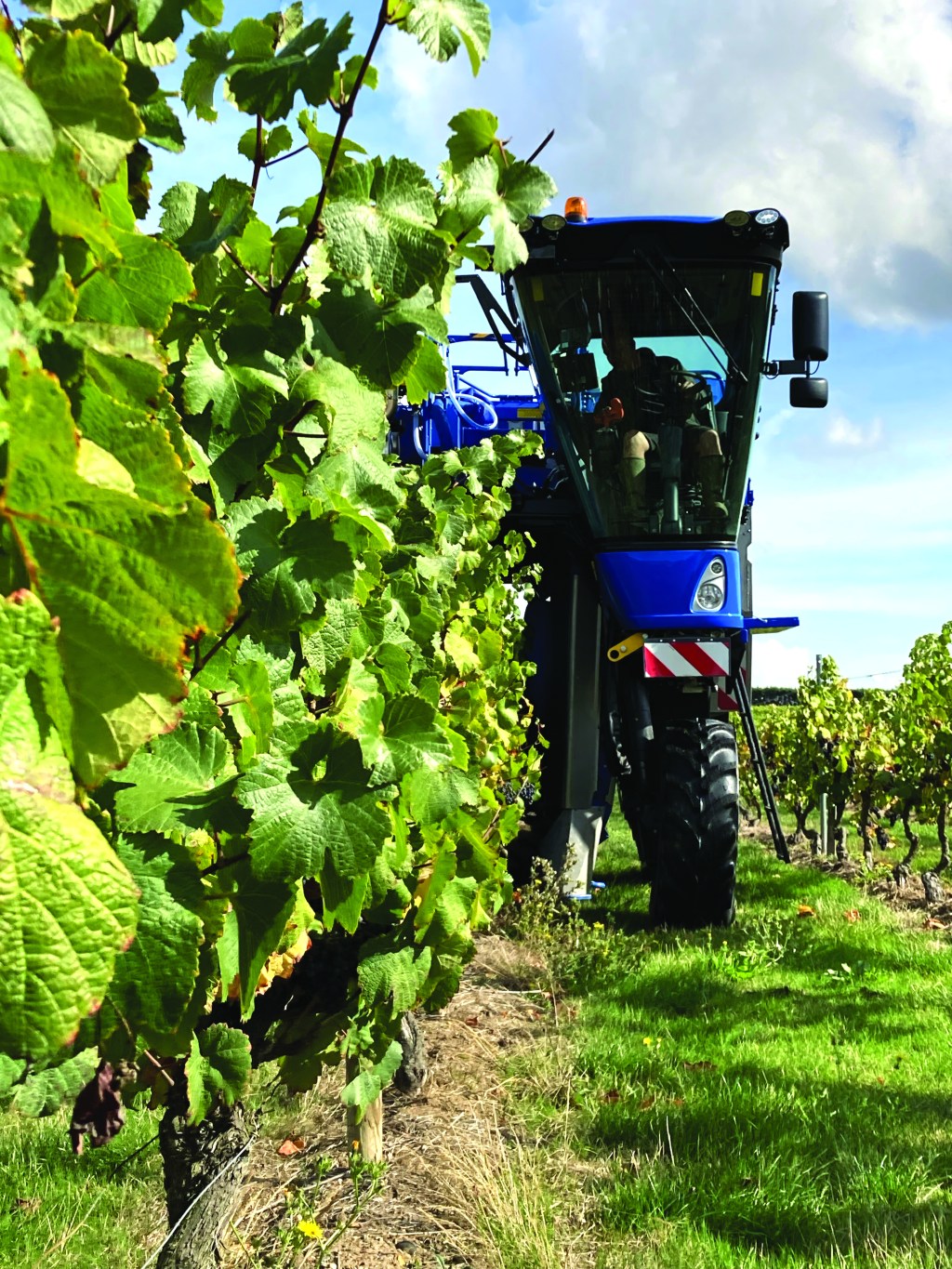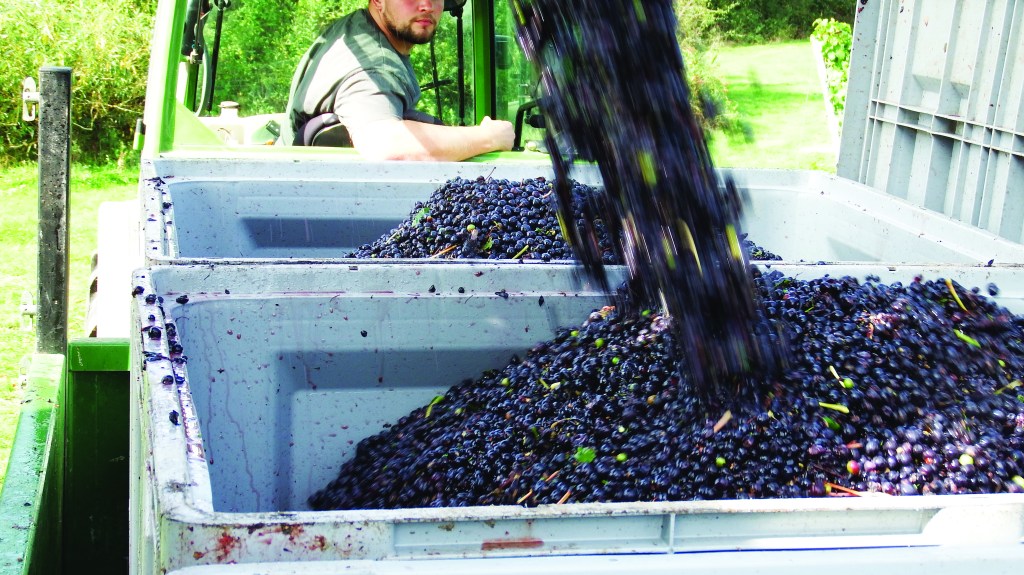Is the UK starting to follow in the footsteps of other wine regions around the world who use machine harvesting for their quality wines, as well as for bulk production? Maybe machine harvesting is already widespread, and this is a turning point in the sector – but producers are keeping quiet? Jo Cowderoy speaks to some of those who have taken the plunge and are machine harvesting, finding cost and time efficiencies – and are surprised by the quality.
There still exists some snobbery around mechanically harvested fruit associating it with poorer quality bulk wine – but advances in technology mean that latest machine harvesters are better at preserving fruit quality, and tastings of hand-picked verses machine-picked fruit reportedly show little difference.
Taking the plunge
New Hall Wine Estate is a family-owned business, in Essex, which includes 59 hectares of vineyards and a newly built winery with 250hl capacity handling around 180-220 tonnes of fruit each year for their own production and a few contract customers. Although not mentioned in the Magna Carta, there are reports of vineyards in the area at around 1120 AD, producing wine to be served to royalty in London.
Taking a well calculated and considered investment, Chris Trembath, Partner, has bought the first brand new self-propelled New Holland machine harvester is the country. “I’m excited and have purchased it for all the right reasons – it’s financially viable,” commented Chris. “I can see labour shortage and labour costs becoming more of an issue in the future, and this was a factor in the decision making,” Chris added.
“For us the main advantage of a machine harvester is the increased control over our harvest to ensure the quality of the fruit. This includes the speed of harvest, having the flexibility to work around the weather and importantly – harvest when the fruit is at optimum ripeness. With our area we would need 50 people and we would have to harvest when the labour was available – so now harvest is much less stressful,” said Chris.
New Hall is situated near Chelmsford in the Crouch Valley, which is now one of the most rapidly expanding viticulture areas in the country due to its low frost risk, warmer temperature, lower rainfall, and fertile clay soils. The area is gaining a reputation for producing some top-quality Pinot Noir. In fact, the published research work by Dr Alistair Nesbitt identified the potential of the area a few years ago.
The New Holland harvester is supplied by Ernest Doe – a family company headed up by Angus Doe, who is the fifth generation. The company has 19 depots across the south east and eastern England, so service and support for their clients is never far away. In fact, the company were New Holland dealer of the year in 2021. “This is the first machine harvester we have sold to a vineyard, but we now have a number of enquiries from other vineyards,” commented Angus.
New Holland is a well-known name and leading brand of machine harvesters in many wine regions of Europe and worldwide, known for machine harvesters as well as their specialised narrow width tractors and equipment. New Holland are manufacturing around 500 machine harvesters a year, with a usual lead time of around six months. However, Chris Trembath found that his order in June was delivered before harvest started in September.
Tom Wheatly, Viticulture and Fruit Specialist with Ernst Doe, commented: “Although this is the first we have sold in the UK, our mechanics at key depots will receive product training to provide support along with parts and service. Parts are either in stock or sent from New Holland’s UK distribution centre, or from France in about a day.”
Philippe Boisseau, New Holland Worldwide Grape Harvester Specialist explained: “The machine straddles the row, and the suspended picking head uses a shaking system, where the plastic bars vibrate and it’s their acceleration rather than physical contact that removes the berries. The programme can be adjusted so that the frequency can suit the fruit and harvest conditions. The synchronised noria buckets gently carry the fruit to the tank at the top of the machine. It can carry about 3.2 tonnes of fruit. Blowers and de-stemmers/sorters remove the unwanted stems and leaves. The machine can be multifunctional, for example the picking head can be removed and replaced by a sprayer.”
The task of operating the machine harvester has been given to Andy Hares, New Hall’s Vineyard & Estate Manager, after some training from New Holland technicians. “You need to get the forward speed, vibration speed and width right for each vineyard block. It’s a bit of trial and error, so I do around 10m in the row and then sample the fruit in the tank. You need to consider the ripeness of the fruit, whether the grapes are thick or thin skinned – but the settings can be saved for each block. As well as an auto height levelling, there is an auto-steer function – but you need to be brave to use it,” exclaimed Andy.
“Some of the wooden trellis posts in our older vineyards are not ideal, but the suspended picking head is flexible, and the width of the ‘pinch’ can be adjusted. If setting up new vineyards for machine harvesting it would be wise to have a modern metal trellis and headlands of 10m,” commented Andy.
“The machine takes about one and half hours to harvest a hectare, which means about five or six hectares a day. The minimum row width for this model is 2m, but there are other machines in the range, also able to harvest blackcurrant,” added Philippe.
Charles Palmer, owner of Charles Palmer Vineyards, in East Sussex has also taken the plunge and invested in a new trailed Pellenc Grape Line 80 machine harvester. The vineyards cover 14 hectares and make a range of both still and sparkling wines. “In 2020 we had a nightmare getting the number of pickers we needed, mainly because of the Covid-19 pandemic. We never knew how many would turn up – sometimes there were only ten,” explained Charles.
“It was impossible to work like that, so we knew we had to address the problem. I went to see contractor SJ Barnes demonstrating a machine harvester and was very impressed. However, I needed to see how the machine would operate on our own vineyards before I invested, so we used Sam Barnes contract services for some of our crop last year. Again, I was very impressed with the speed and the quality, so straight after last harvest I ordered my own machine harvester,” said Charles.
“There are so many advantages to machine harvesting. We can pick at optimum quality, not too early or too late. We also found that picker’s abilities vary – some are good and stick to the quality parameters given, but many are sub-standard. Managing a picking team has become so frustrating and stressful – and the costs are soaring!
“With a machine you set it up for the block and it harvests with a dependable quality. With the correct settings for the degree of vigour – how hard it shakes the vine – the green berries and botrytis infected berries can be left behind. It has a grading table at the top of the machine and only clean fruit falls through – all the stems, petioles and leaves are blown away. So, in our view, the machine is better in terms of quality,” added Charles.
“I have calculated that with the annual payments, depreciation, fuel, and a tractor driver I am saving nearly 30% over hand harvesting. When the machine is fully paid for, I expect this saving will increase. Although the decision to purchase the machine harvester was financial, with the quality and control over harvest and the peace of mind, I would now consider switching to a machine even without the savings. If you are late pruning it’s not the end of the world, but if you are late harvesting and you see all your hard work deteriorating on the vine – it is,” said Charles.
Contract services
Sam Barnes, from S.J Barnes Ltd, began offering contract machine harvesting four years ago and due to increased demand, bought a second trailed Pellenc Grape Line machine last year. “The demand has been incredible. In year one we machine harvested 40 hectares, in year two over 100 hectares. Last year with a second machine we did 170 hectares and this year we will top 200 hectares,” commented Sam.
Machine harvesting is usually considered more suitable for fruit destined for still wine production, but in Sam Barnes’ experience a lot of fruit for sparkling, including traditional method, is now being machine harvested. “Last year about 70% of the fruit we machine harvested was for fizz,” commented Sam. “This year the split is nearer 60:40 for stills – but this is because vineyards are achieving the ripeness needed to make more still wines,” he added.
“I think in previous years the risk of labour shortages pushed the decision to machine harvest for many, but this year we have the challenge of higher volumes as well. There is a growing acceptance of machine harvesting as more vineyards and wineries are experiencing the benefits, seeing cost savings, and appreciating the ease of machine harvesting,” added Sam.
“As a ballpark figure, the cost of hand harvesting – considering labour costs for picking and the time taken handling crates is around £350-400 per tonne. The cost of machine harvesting using contract services is around £100 per tonne,” explained Sam.
Sam Linter, Managing Director, Bolney Wine Estate, in West Sussex, has been using S.J Barnes machine harvesting contract services for a couple of years. “We use a machine harvester for a proportion of our grapes as there are so many advantages and we are happy with the results and quality.
What about quality?
“I was not in favour of a machine harvester at first,” said Lucy Winward, New Hall’s Commercial Manager who oversees winemaking, “but now I am seeing the benefits – for a start we can pick the fruit exactly when we want to, whereas previously when we were dependant on labour, we could have under ripe or over ripe fruit coming into the winery. I am seeing a surprising increase in juice quality, with less unripe fruit, but also it is destemmed in the machine, so the winery operations are more efficient. We mainly produce still wines, but I am planning some trials using machine harvested fruit for our sparkling production,” added Lucy
We did some trials with our 2020 Chardonnay at Bolney, comparing the juice from machine and hand harvested fruit,” commented Sam Linter. “We found the flavours more pronounced with the machine harvested fruit,” she added.
“One advantage, which helps quality, is the speed that we can get the fruit in to the press, and it remains cool. This is particularly important with fruit that is not from our local vineyards. Fruit that is hand-picked can end up sitting in crates for hours, often getting warm. Hand harvesting also brings with it issues such as organising and providing facilities for picking crews, the logistics of transporting, washing crates – all of which can be stressful,” said Sam.
More still wines
Dr Alistair Nesbitt is CEO of Vinescapes Ltd and renowned for his research work in climate change and viticulture. His paper, ‘Climate change projections for UK viticulture to 2040: a focus on improving suitability for Pinot Noir’ was published in Oeno One in July 2022. “The study shows how the climate of a larger area of England and Wales is projected to become suitable for reliably growing sparkling wine grape varieties, and how the potential for high quality still wine production is rapidly emerging,” explained Dr Nesbitt.
Winemaking considerations
David Cowderoy, consultant winemaker and Managing Director of BevTech Ltd, has made wine in over 30 wine regions around the world – and the vast majority has been from machine harvested fruit. “Machine harvesting can offer a lot of advantages in the vineyard, but there are some important winemaking considerations that need to be taken into account,” explained David. “The potential for oxidation is much greater which can have a very negative impact on aromatics. At the very least SO2 should be added as soon as possible. Sometimes drippers with an SO2 solution can be used on the harvester itself – but it is very hard to get the dose just right and yet another thing for the driver of the harvester to control. A simpler method is to add powdered PMS to the bins as the grapes are transferred from the harvester – but care needs to be taken to ensure even distribution,” David added.
“On its own SO2 is not a good oxygen scavenger, so using ascorbic acid in addition will have a huge effect of reducing oxidation, but this is something than should only be done with full knowledge of the implications of working with ascorbic acid – in particular maintaining sufficiently high free SO2 levels,” advised David.
“Skin contact is of course another consideration because colour and tannin pickup will increase and so proteinaceous fining agents, PVPP or carbon may be advantageous – particularly if there is a significant time period between harvesting and pressing. Also, the percentage of juice lees post racking will also tend to be higher than hand harvested fruit. This can have important economic implications if there is no facility at the winery to recover juice from lees,” added David.
“The winery team need to adapt to machine harvested fruit,” explained Charles. “The downside is that there is the potential for oxidation in the bins, so the fruit needs to be transported to the winery and into the press as quickly as possible. The timing of winery operations becomes more important as everything must be processed the same day. On the plus side the grapes are arriving at the winery nice and cool, at around 12°C, which slows oxidation.
“We find that the press operations are slightly different with machine harvested fruit compared to whole bunch, as the berries will have broken skin and more juicing. We limit pressure to 1.4 bar and aim for about 60% juice yield before settling and racking off its primary lees. However, we are now using the machine harvester for all our wine, the red, white, and rose stills as well as the sparkling,” added Charles.
Is this a turning point?
Sam Linter is also Chair of WineGB and sees machine harvesting as a key turning point in the UK wine sector. “As labour becomes more difficult to secure, and more expensive, I can see machine harvesting bringing efficiencies and cost savings. I also think we will see press centres being positioned around the regions so that juice rather than grapes can be transported,” Sam added.
“I’m definitely seeing more interest in machine harvesting,” explained Joel Jorgensen, Viticulturist and Managing Director of Vinescapes Ltd. “This is mainly due to cost savings, and I think they are likely to be the way forward – as seen in the rest of the world, and especially if the focus on stills increases. However, they are a large investment for once-a-year use, so the vineyard needs to be of a certain size with enough work for the machine to pay for itself. Other options are to ‘buddy up’ with a neighbour or use contract services.
“The cost savings on labour are certainly a consideration for many. If a machine harvest can shift about 35 tonnes a day, by my rough calculations, that would need the equivalent of around 90 pickers, probably earning around £15 an hour. It’s much less complicated to manage one machine than 90 pickers,” exclaimed Joel. “However, I remember seeing some comparative figures a few years back that there is not always such a difference in machine verses hand harvesting costs in certain situations. If the vineyard is easy to pick, the fruit is exposed, and the bunches are large – a good team of pickers can move very quickly and efficiently through a vineyard.
“One challenge we have in the UK is that many of our vineyards are small and situated down tiny winding country lanes. I can’t imagine that a contractor would be keen to negotiate the route for a small volume of fruit – it’s just not feasible. This begs the question that the small boutique vineyards could become disadvantaged, their fruit becoming more expensive to pick, financial margins becoming tighter and the costs gap may make the price point of the wine higher. Another challenge is disease levels; machine harvesters will gather fruit that is infected with powdery mildew or botrytis as well as clean fruit,” added Joel.
- Machine harvested fruit at Charles Palmer Vineyards
- Inside view of the Pellenc harvester at Charles Palmer Vineyards
- Pellenc Grape Line 80 machine harvester at Charles Palmer Vineyards
- Andy Hares, New Hall Wine Estate
- Sam Barnes, from S.J Barnes Ltd, began offering contract machine harvesting four years ago

